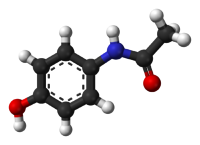Paracetamol as a common pain reliever
This resources mentions in brief and in simple words, information about the commonly used medicine to reduce fever and pain - Paracetamol. This resources is also helpful for students of the medical profession who are preparing for exams and need a ready at hand information about drug information, identifiers, chemical formula and other ready reckoner for Paracetamol.

Introduction to Paracetamol
Paracetamol is the common name for N-(4-hydroxyphenyl)ethanamide and N-(4-hydroxyphenyl)acetamide which is one of the commonest and oldest medicine used under the Modern Medicine - Allopathic mode of treatment for Fevers. Paracetamol is also known by the name - Acetaminophen.
Paracetamol belongs to Anilides Class of Analgesics.Legal status of Paracetamol
The Pregnancy category for Paracetamol is A(AU) B(AU) safe. It is legalised as Unscheduled (AU) GSL (UK) OTC (US).Route of Administration of Paracetamol
Paracetamol is the oldest of known Antipyretics, Mild Analgesics and Anti Inflammatory medicine. It has administered through Oral Route, Intramuscular route, Intravenous route and even through Rectal route.Pharmacokinetic data of Paracetamol
Bioavailability of Paracetamol - Paracetamol is available and chemically prepared in abundance thus nearing to 100% bioavailibility.
Metabolism of Paracetamol - Paracetamol is metabolised in the Liver (Hepatic system) by nearly 90 to 95%.
Half Life of Paracetamol - The half life of Paracetamol ranges in between 1 hour to 4 hours.
Excretion of Paracetamol - The drug Paracetamol is excreted through the Renal System and thus through the Urine.Identifiers of Paracetamol
CAS number of Paracetamol - 103-90-2
ATC code of Paracetamol - N02BE01
PubChem of Paracetamol - CID 1983
DrugBank of Paracetamol - DB00316
ChemSpider of Paracetamol - 1906
UNII of Paracetamol - 362O9ITL9D
KEGG of Paracetamol - D00217
ChEBI of Paracetamol - [1]
ChEMBL of Paracetamol - CHEMBL112Chemical data of Paracetamol
Formula of Paracetamol - C8H9NO2
Mol. mass of Paracetamol - 151.17 g/mol
SMILES of Paracetamol - eMolecules & PubChemPhysical data of Paracetamol
Density of Paracetamol - 1.263 g/cm3
Melting point of Paracetamol - 169 °C (336 °F)
Solubility in water of Paracetamol - 12.78 mg/mL (20 °C)Medical uses of Paracetamol
Paracetamol for Fever
Paracetamol can be used in people of all ages and both sexes in Human beings and also to a large extent in lower animals in varied doses. The World Health Organisation recommends that only Paracetamol be used for reducing fever conditions in children and Pediatric age group children when the Fever goes above 38.5 °C (101.3 °F)
Paracetamol in Pain
Given the action of Paracetamol on nearly every part of the body, Paracetamol is thus recommended for pain related complaints and for the relief of it in the Human body. The capability of Paracetamol to reduce pain is comparable to that of Aspirin, although the ability to reduce inflammation as compared to that of Aspirin is weaker.
But Paracetamol scores over Aspirin when the question comes to those patients suffering from excessive gastric secretions, acidity related complaints, Gastric and intestinal ulcers and those with prolonged bleeding times; Paracetamol becomes a drug of choice.
Paracetemol is also useful in cases of mild type of Arthritis. It can relieve the pain but cannot reduce the inflammation, redness (rubor), swelling (tumor) in cases of the Osteoarthritis of the knee.
Paracetamol comes under the Non Steroidal Anti-Inflammatory Drugs (NSAIDs) and is effective as compared to Ibuprofen under the class of Pain relievers.
